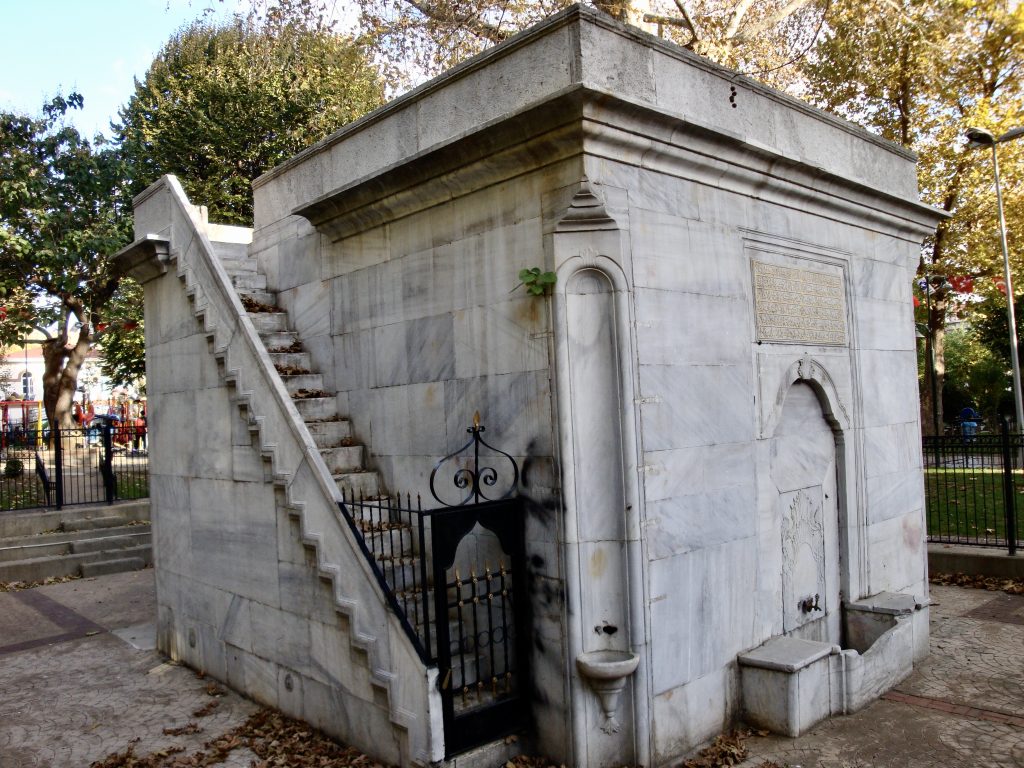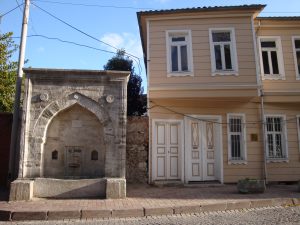 Just a few years ago few tourists to Sultanahmet ventured downhill behind the Arasta Bazaar to visit the wonderful Kücük Ayasofya Cami. Even fewer continued on into Kadırga, then a solidly residential part of the city with pretty, sometimes crumbling, sometimes beautifully restored houses grouped around a small central park.
Just a few years ago few tourists to Sultanahmet ventured downhill behind the Arasta Bazaar to visit the wonderful Kücük Ayasofya Cami. Even fewer continued on into Kadırga, then a solidly residential part of the city with pretty, sometimes crumbling, sometimes beautifully restored houses grouped around a small central park.
The suburb is probably named after an early Ottoman sailing vessel in a nod of recognition to the fact that it stands on the site of what was an important Byzantine port, originally founded in the 4th century, expanded in the 6th and still in use in early Ottoman days.
As the demand for land for new hotels in Sultanahmet pushed up prices there hoteliers started looking further afield and now they have discovered Kadırga, with new properties opening on a monthly basis. It’s probably inevitable that the suburb will eventually lose its current pleasantly residential feel, especially now that the Marmaray, with its main European terminal in nearby Yenikapı, has opened. But in the meantime you will be able to admire a mixture of small wooden houses, some of them pleasingly restored, as well as entire streets of terraced stone houses, some of them running down alarmingly steep streets behind the park.
The best way to reach Kadırga from Sultanahmet is to walk to the end of the Hippodrome and then bear left downhill. This will take you past the crumbling remains of the Sphendone. If you walk past on a Wednesday you will see a local street market taking place right beside these ancient remains.
Around Kadırga
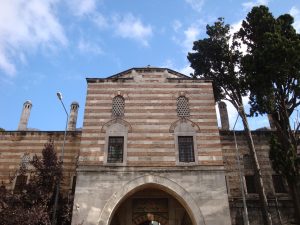 The most important monument in Kadırga has to be the wonderful Sinan-designed Sokollu Mehmed Paşa Cami whose main entrance leads upstairs through a gateway built beneath what was once the main lecture hall of the medrese housed in the porticoes around its courtyard. The mosque was designed in 1571 for Esmahan Sultan, the wife of the grand vizier, Sokollu Mehmed Paşa, and pieces of the Ka’aba in Mecca were incorporated into its mihrab and mimber. Most visitors will probably be most impressed by the lovely İzmik tiles that coat the walls and by the way in which sunlight filters into the unexpectedly compact interior through colourful stained-glass windows.
The most important monument in Kadırga has to be the wonderful Sinan-designed Sokollu Mehmed Paşa Cami whose main entrance leads upstairs through a gateway built beneath what was once the main lecture hall of the medrese housed in the porticoes around its courtyard. The mosque was designed in 1571 for Esmahan Sultan, the wife of the grand vizier, Sokollu Mehmed Paşa, and pieces of the Ka’aba in Mecca were incorporated into its mihrab and mimber. Most visitors will probably be most impressed by the lovely İzmik tiles that coat the walls and by the way in which sunlight filters into the unexpectedly compact interior through colourful stained-glass windows.
Across the road from the side entrance into the mosque stands the rebuilt and aubergine-painted Özbekler Tekkesi (Uzbek Lodge) which was originally built in 1692 but rebuilt in 1887 after which it came to be associated with the Uzbek Sufi leader Şeyh Sadi Efendi. Unusually, its minaret is perched immediately above the entrance. Today it is used as a school of arts and crafts. 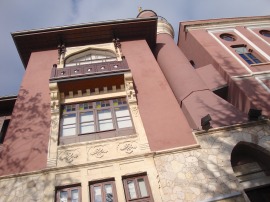 Özbekler Tekkesi
Özbekler Tekkesi
Heading west from the mosque you come to Kadırga Park, the heart of the suburb, with a pond and children’s playground in the middle of it. Here you will see one of the few namazgahs (outdoor praying areas) in İstanbul. It was designed in 1781 for Esma Sultan, the daughter of Sultan Ahmed III. Worshippers would mount the steps beside the ablutions fountains at the bottom to reach the praying area on top of it.
Just beside the park is the delightful, state-of-the-art Istanbul Photographic Museum (closed Mondays, www.istanbulfotografmuzesi.com) with galleries devoted to Turkish photographers, a timeline for the history of the art and a room for temporary exhibitions.
Also near the park is the Kadırga Hamam, originally built in 1506 but rebuilt in 1734 and once very popular with sailors returning from long voyages. Today it’s still in business with separate sections for men and women. While not as splendid architecturally as the Ayasofya Hürrem Sultan, Çagaloğlu and Çemberlitaş hamams, it is – at least for the time being – more “authentic” and certainly cheaper to use.
Eating and drinking
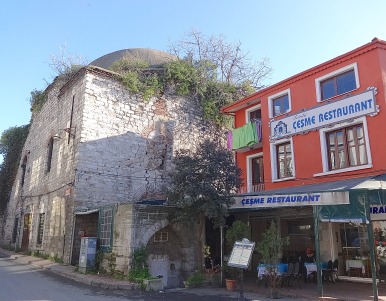 Tarihi Çeşme Restaurant (Historic Fountain Restaurant) Right beside the ancient fountain that gave it its name, this small lokanta attracts a devoted band of followers for its un-gimmicky, reasonably priced Turkish staples. Kadırga Liman Caddesi, Küçük Ayasofya Cami Sokak No. 1, Tel; 0212-516 3580
Tarihi Çeşme Restaurant (Historic Fountain Restaurant) Right beside the ancient fountain that gave it its name, this small lokanta attracts a devoted band of followers for its un-gimmicky, reasonably priced Turkish staples. Kadırga Liman Caddesi, Küçük Ayasofya Cami Sokak No. 1, Tel; 0212-516 3580
Right beside the park is the Tarihi Havuz Lokantası (Historic Lokanta with a Pool), a traditional tea-house centred on a lovely indoor fountain. Behind it is the pump that supplied it with water shaded in an ancient planet tree. It’s well worth stopping by for a çay.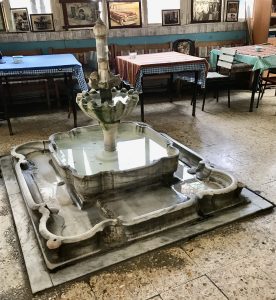
Sleeping
Arena Hotel. Tel: 0212-458 0364
Hotel Ayasofya In a quiet side-street location, this hotel has an energetic Australian manageress who has brought style and flair to the rooms. The rooftop terrace offers the same Sea of Marmara views as more expensive hotels but at a fraction of the price. Tel: 0212-516 9446
Hotel Sidera Palace. Tel: 0212-638 3460
Ottoman Hotel Park In a great location overlooking the park, this hotel brings Ottoman-style luxury to a neighbourhood once associated with more basic accommodation. Its rooftop Tabbah Restaurant offers splendid views over the Sea of Marmara. Tel: 0212-516 0211
Turkuaz Guesthouse With its bright-blue facade, this idiosyncratic hotel housed in an old wooden house overlooking a local football pitch goes for the antique look. Some visitors adore it, others find it a little too off-the-beaten-track. Tel: 0212-518 1897
 Villa Hagia Sophia Charming bijou hotel in restored wooden house. Rooms are smallish, with smart modern décor including, in some cases, bathtubs in the bedroom. Breakfasts are excellent. Küçük Ayasofya Medresesi Sokak No.6, Tel: 0212-458 1122
Villa Hagia Sophia Charming bijou hotel in restored wooden house. Rooms are smallish, with smart modern décor including, in some cases, bathtubs in the bedroom. Breakfasts are excellent. Küçük Ayasofya Medresesi Sokak No.6, Tel: 0212-458 1122
Transport info
You can either walk down to Kadırga from Sultanahmet via the Hippodrome or take one of the side streets down from Divan Yolu.
Nearby areas
